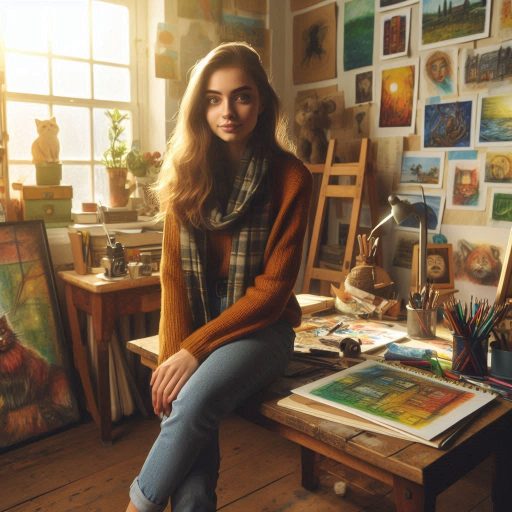Introduction
Concept artists play a crucial role in various industries, including film, video games, and animation.
They are the visionaries who transform ideas into visual concepts, bridging the gap between imagination and reality.
By creating initial designs, they set the tone and style for projects, guiding teams throughout the creative process.
Their work involves generating visual representations of characters, environments, and objects, which serve as blueprints for further development.
This foundational work is essential for establishing a cohesive aesthetic and narrative direction.
Without concept artists, many creative projects would lack the visual clarity and emotional impact necessary to engage audiences.
The importance of concept artists extends beyond mere illustration.
Their designs influence every aspect of production, from character development to set design.
As such, they have a significant impact on the final product, ensuring that the vision is consistently realized across various mediums.
By collaborating with directors, designers, and other professionals, concept artists help shape memorable experiences that resonate with viewers and players alike.
What is a concept artist?
A concept artist plays a vital role in the creative process of various industries, especially in entertainment.
They focus on visualizing ideas and concepts before production begins.
This role involves creating artwork that captures the essence of characters, environments, and objects.
Concept artists contribute to films, video games, and animations, helping to establish the visual style of a project.
Defining the Role
The primary responsibility of a concept artist is to develop visual representations of ideas.
They work closely with directors and designers to understand the project’s vision.
They produce sketches, illustrations, and digital paintings to convey these ideas effectively.
Concept artists often create character designs, environment art, and props, establishing the look and feel of the project.
Additionally, they may participate in brainstorming sessions, offering their insights on design and aesthetics.
Concept artists also need to adapt their styles to match the project’s requirements.
They work on multiple iterations of designs based on feedback from the team.
This flexibility helps ensure that the final product aligns with the original vision.
Skills and Qualifications
To become a successful concept artist, one must possess a mix of artistic and technical skills.
Proficiency in drawing and painting is essential.
Concept artists should understand color theory, composition, and anatomy.
These skills help them create believable and engaging designs.
Familiarity with digital tools is also crucial.
Many concept artists use software like Adobe Photoshop, Illustrator, and 3D modeling programs.
These tools enhance their ability to create polished artwork and allow for easier revisions.
Strong communication skills are essential as well.
Concept artists must articulate their ideas clearly to team members.
They often collaborate with other artists, animators, and producers, making teamwork vital to success.
Being open to feedback and adapting designs accordingly is also important.
A solid educational background can boost a concept artist’s career.
Many artists pursue degrees in fine arts, illustration, or design.
Formal education provides a foundation in artistic principles and techniques.
However, many successful concept artists are self-taught or have attended workshops and courses.
Building a strong portfolio is key to entering the industry.
A well-curated portfolio showcases an artist’s skills and style.
It should include a range of work, demonstrating versatility and creativity.
Networking within the industry can open doors to job opportunities and collaborations.
A concept artist plays a pivotal role in visual storytelling.
They bring ideas to life through their artistic talents.
By honing their skills and creating a standout portfolio, aspiring concept artists can carve a successful career in this dynamic field.
Read: Famous Costume Designers in Hollywood
The creative process of a concept artist
Steps Involved in the Creative Process of a Concept Artist, Including Research, Ideation, and Visualization
The creative process of a concept artist involves several key steps that play a vital role in transforming ideas into visual representations.
Understanding these steps helps illustrate how concept artists bring projects to life.
The first step involves thorough research.
Concept artists gather information related to the project’s theme, style, and context.
They analyze existing works, trends, and relevant materials.
This groundwork informs their artistic decisions and helps them understand the project’s needs.
After research, artists move into the ideation phase.
This step involves brainstorming ideas and sketching preliminary concepts.
Artists create multiple rough sketches to explore different directions.
They experiment with various styles, character designs, and environments.
This phase focuses on generating a wide range of ideas without self-judgment.
Once the ideation phase is complete, artists begin to visualize their chosen concepts.
They refine their sketches into more polished artworks.
This may include detailed illustrations or digital paintings that showcase color, texture, and form.
Visualization helps communicate the final look of characters, props, or environments effectively.
Concept artists often present their work to the creative team for feedback.
This step is crucial for aligning the designs with the project vision.
Artists may receive constructive criticism and suggestions, prompting revisions.
The iterative nature of this phase ensures the final designs meet the project’s requirements.
Once revisions are complete, concept artists finalize their designs.
They prepare detailed concept sheets that include different angles and expressions.
These sheets serve as guides for the production team, including animators and modelers.
Finalizing designs marks the transition from concept to production.
Examples of Famous Concept Artists and Their Works to Illustrate the Creative Process
Several renowned concept artists have significantly impacted the industry through their creative processes.
For example, Ralph McQuarrie is famous for his work on the Star Wars franchise.
His concept art helped define the visual style of the original trilogy.
McQuarrie’s designs for iconic characters like Darth Vader and Yoda are legendary.
Another influential artist is Feng Zhu, known for his work in games and films.
His concept art emphasizes environments and vehicles, showcasing a detailed understanding of form and function.
Zhu’s designs for Star Wars: The Old Republic exemplify his ability to blend creativity with technical skills.
Kris Anka is also a notable concept artist who has worked on major comic book titles and video games.
His character designs for games like Marvel’s Spider-Man illustrate his expertise in character aesthetics and storytelling through visuals.
These artists exemplify the creative process, demonstrating how research, ideation, and visualization come together in concept art.
Their work enriches their respective projects and inspires aspiring concept artists to explore their creative potential.
By understanding and following these steps, emerging artists can develop their unique styles and contribute meaningfully to the visual storytelling landscape.
Collaboration with other professionals
How Concept Artists Work Closely with Art Directors, Designers, and Other Professionals to Bring Their Ideas to Life
Collaboration is essential for concept artists as they work within creative teams.
Concept artists engage closely with art directors, designers, and other professionals throughout the project.
They start by discussing the project’s vision and goals with the art director.
This initial communication sets the stage for a unified creative direction.
Once the vision is clear, concept artists share their ideas and sketches with designers.
They discuss design elements, color palettes, and overall aesthetics.
This interaction allows artists to gather feedback and refine their concepts.
By aligning their ideas with the design team’s goals, concept artists ensure their work fits seamlessly into the broader project.
During the production phase, concept artists continue collaborating with animators and modelers.
They provide detailed designs and specifications, ensuring their concepts translate effectively into 3D models or animations.
This collaboration is vital for maintaining consistency in the final product.
Importance of Communication and Teamwork in the Collaborative Process
Effective communication is crucial for successful collaboration.
Concept artists must articulate their ideas clearly to team members.
They share their vision through presentations, concept sheets, and visual references.
This clarity helps avoid misunderstandings and keeps everyone on the same page.
Teamwork plays a significant role in bringing concepts to life.
Artists rely on the expertise of art directors and designers to enhance their work.
Collaborative brainstorming sessions can lead to innovative ideas that might not emerge in isolation.
Each team member brings unique skills to the table, creating a richer creative environment.
The iterative nature of the creative process also emphasizes collaboration.
Concept artists frequently receive feedback from their peers.
This feedback loop encourages open dialogue and fosters a supportive atmosphere.
Constructive criticism helps artists refine their designs and elevate the quality of their work.
Moreover, collaboration allows concept artists to learn from others.
They can observe different approaches and techniques used by fellow professionals.
This exchange of knowledge can inspire growth and improvement in their artistic abilities.
Collaboration is vital for concept artists as they work with various professionals.
Their ability to communicate effectively and work as part of a team directly impacts the success of the project.
Read: Essential Skills for Aspiring Costume Designers

Industry insights
Different Industries That Employ Concept Artists
Concept artists play a crucial role across various industries.
The entertainment sector, including film, television, and video games, employs many concept artists.
They help visualize characters, environments, and story elements.
Their creativity shapes the audience’s perception, making it essential for captivating storytelling.
In the entertainment industry, concept artists create artwork that guides the overall design process.
They develop ideas that define the look and feel of the project.
By providing a visual reference, they ensure that everyone involved understands the creative vision.
This visual clarity fosters consistency in design and enhances collaboration among team members.
In advertising, concept artists create compelling visuals for campaigns.
They develop illustrations and concepts that resonate with target audiences.
Their work enhances branding and marketing strategies, driving consumer engagement.
Concept artists collaborate with copywriters and marketers to ensure cohesive messaging that aligns with brand identity.
Publishing is another industry that values concept artists.
They design book covers, illustrations, and layouts for various genres.
Their artistic vision attracts readers and conveys the essence of the story.
Concept artists work closely with authors and editors to create visuals that enhance the narrative and attract the right audience.
Job Outlook for Concept Artists and Potential Career Paths in the Industry
The job outlook for concept artists remains positive.
As visual media continues to grow, the demand for skilled artists increases.
The rise of digital content, animated features, and virtual reality experiences further expands opportunities in this field.
Career paths for concept artists are diverse.
Many start as junior artists, gradually advancing to senior roles.
With experience, some may transition into art direction or creative leadership positions.
Others may choose to specialize in specific areas, such as character design or environmental art.
This specialization allows them to refine their skills and develop a unique artistic voice.
Freelancing is another viable career option for concept artists.
Many artists enjoy the flexibility of working on various projects across different industries.
Freelancers often build a diverse portfolio, showcasing their versatility and range.
This adaptability allows them to attract a wider client base and explore different creative challenges.
Networking and professional development are essential for success in this field.
Attending industry events, workshops, and conferences helps artists connect with potential employers.
Continuous learning through online courses and tutorials also enhances their skill set, keeping them competitive in a rapidly evolving industry.
Concept artists contribute significantly to multiple industries, including entertainment, advertising, and publishing.
The job outlook remains strong, with various career paths available for aspiring artists.
By staying adaptable and continuously improving their skills, concept artists can thrive in this dynamic and creative field.
Read: Visual Merchandiser: Job Market and Opportunities
Tools and Technology
Tools and Software Commonly Used by Concept Artists
Concept artists rely on various tools and software to bring their ideas to life.
Adobe Photoshop is a staple in the industry, widely used for digital painting and editing.
Its versatile features allow artists to create detailed illustrations, manipulate images, and experiment with colors and textures.
Procreate has gained popularity among concept artists, especially for iPad users.
This intuitive app offers a natural drawing experience and a wide range of brushes and tools.
Artists appreciate its portability and ease of use for sketching and painting on the go.
SketchUp serves a different purpose in the concept art realm.
It is primarily used for creating 3D models and environments.
Concept artists use SketchUp to visualize spaces, helping them design intricate backgrounds and layouts.
This software allows for easy modifications and provides a solid foundation for more detailed artwork.
Other useful tools include Clip Studio Paint and Corel Painter, both designed for digital painting.
They offer unique brush engines and features that cater to different artistic styles.
Artists often experiment with multiple software to find the best fit for their workflow.
Role of Technology in Shaping the Field of Concept Art
Technology plays a crucial role in shaping the field of concept art.
It has transformed traditional artistic practices into digital processes that enhance creativity and efficiency.
Digital tools enable concept artists to iterate quickly, making it easier to refine ideas and share them with collaborators.
Staying up-to-date with new tools is vital for concept artists.
As technology evolves, new software and features emerge that can streamline workflows and improve artistic capabilities.
By embracing these advancements, artists can stay competitive and innovative in their work.
In addition to software, advancements in hardware also impact the industry.
Graphics tablets, such as those from Wacom, allow for more precise and natural drawing experiences.
Similarly, powerful computers ensure that artists can run demanding software without lag, facilitating a smoother creative process.
Furthermore, emerging technologies like virtual reality (VR) and augmented reality (AR) are beginning to influence concept art.
These technologies provide immersive experiences that can enhance storytelling and visualization.
Concept artists who understand and utilize these tools will have a distinct advantage in the industry.
The right tools and technology are essential for concept artists.
Software like Photoshop, Procreate, and SketchUp helps bring their visions to life.
Embracing new technologies ensures that artists remain relevant and capable of pushing the boundaries of their craft.
By continuously evolving their skills and knowledge, concept artists can create captivating visuals that resonate across various industries.
Read: Visual Merchandising: Best Practices for Beginners
Portfolio and networking
Tips on Building a Strong Portfolio
A strong portfolio is essential for any concept artist seeking to showcase their skills and creativity.
Begin by curating a diverse selection of your best work.
Include pieces that highlight various styles, techniques, and subjects.
This variety demonstrates your versatility and ability to adapt to different projects.
Focus on quality over quantity.
Choose 10 to 15 of your strongest pieces.
Each work should be polished and present your skills effectively.
Consider including detailed sketches, finished illustrations, and even character designs.
This variety illustrates your creative process and artistic range.
Organize your portfolio logically.
Group similar works together, and use clear titles and descriptions for each piece.
Highlight the thought process behind your creations to show potential employers how you approach design challenges.
This context adds depth to your work.
Make your portfolio accessible online.
Create a professional website or use platforms like Behance or ArtStation.
An online portfolio allows for easy sharing and can reach a broader audience.
Keep your website updated with your latest projects and achievements to keep it fresh and engaging.
Networking and Building Connections
Networking is vital for advancing your career as a concept artist.
Attend industry events, conferences, and workshops to meet fellow artists and professionals.
Engage in conversations and express your interest in their work.
Building genuine connections can lead to potential collaborations or job opportunities.
Leverage social media to showcase your work and connect with others in the industry.
Platforms like Instagram and Twitter are popular among artists for sharing portfolios and interacting with peers.
Follow established concept artists and engage with their content.
This interaction can help you gain visibility and attract attention to your work.
Join online communities and forums related to concept art.
Participate in discussions, seek feedback, and share your work for critique.
Many artists have found job opportunities through connections made in these spaces.
Additionally, consider joining local art groups or clubs to connect with others in your area.
Mentorship can be invaluable.
Seek out established concept artists willing to offer guidance and advice.
A mentor can provide insights into the industry and help you refine your skills.
They may also introduce you to valuable contacts within the field.
Finally, be proactive in reaching out to potential employers.
Tailor your approach to each company and demonstrate genuine interest in their work.
A well-crafted email introducing yourself and sharing your portfolio can open doors to interviews and job opportunities.
Building a strong portfolio and networking effectively are crucial for a successful career as a concept artist.
Showcase your skills with a curated selection of your best work.
Engage with others in the industry to foster connections that can lead to future opportunities.
By investing time in these areas, you’ll enhance your career prospects and growth in the concept art field.
Conclusion
In this blog post, we explored the vital role and responsibilities of concept artists in various industries.
Concept artists contribute significantly to the creative process, turning ideas into visual representations that guide projects from inception to completion.
They engage in research, ideation, and visualization, crafting compelling designs that resonate with audiences.
We discussed the skills and qualifications required to succeed in this field.
Strong artistic abilities, a solid understanding of design principles, and proficiency in relevant software are crucial for aspiring concept artists.
Additionally, collaboration with other professionals, such as art directors and designers, is essential for bringing ideas to life.
The post also highlighted the tools and technology that shape the field of concept art.
Staying current with digital tools enhances creativity and efficiency.
Building a strong portfolio and networking effectively are key strategies for advancing one’s career in this competitive industry.
If you have a passion for creativity and visual storytelling, consider pursuing a career in concept art.
With dedication and continuous learning, you can carve out a fulfilling path in this dynamic field.
Embrace your artistic journey and explore the endless possibilities that concept art offers.




